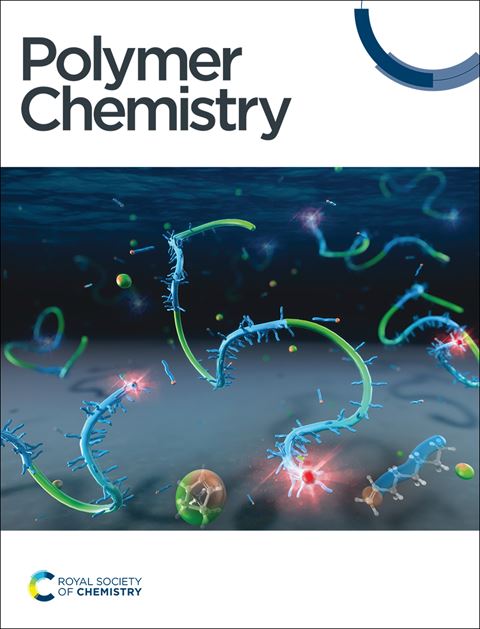Photoactive methylene blue-functionalized polymer for antimicrobial activation under red light†
IF 3.9
2区 化学
Q2 POLYMER SCIENCE
引用次数: 0
Abstract
This study presents the synthesis of a novel methylene blue acrylamide monomer and its incorporation into a diblock copolymer, , which exhibits potent antimicrobial activity against Gram-negative (Escherichia coli, Pseudomonas aeruginosa) and Gram-positive (Staphylococcus aureus) bacteria when photoirradiated under red light (λ = 630 nm). Mechanistic investigations revealed that singlet oxygen species, and not superoxides, are responsible for the antimicrobial activity, most likely by damaging cellular components such as proteins and DNA. The advantage of using red light as an external trigger because of its ability to penetrate skin and tissue is demonstrated here, where is still active against E. coli when irradiated through a cover of chicken skin. In terms of biocompatibility, is, significantly, 130 times more biocompatible than the original methylene blue dye. Overall, this study demonstrates the efficient modification of a red light-active photosensitiser into an antimicrobial macromolecule with improved biological properties for potential photodynamic applications in healthcare.

光活性亚甲基蓝功能化聚合物在红光下的抗菌活性
本研究介绍了一种新型亚甲基蓝丙烯酰胺单体的合成及其在二嵌段共聚物 PolyMB 中的应用,该单体在红光(λ = 630 纳米)照射下对革兰氏阴性菌(大肠杆菌、绿脓杆菌)和革兰氏阳性菌(金黄色葡萄球菌)具有很强的抗菌活性。机理研究表明,单线态氧而不是超氧化物是抗菌活性的原因,很可能是通过破坏蛋白质和 DNA 等细胞成分。由于红光能够穿透皮肤和组织,因此使用红光作为外部触发器的优势在这里得到了证明,当红光透过鸡皮照射时,PolyMB 对大肠杆菌仍有活性。在生物相容性方面,PolyMB 的生物相容性比原来的亚甲基蓝染料高出 130 倍。总之,这项研究表明,红光活性光敏剂被有效地改性成了一种具有更好生物特性的抗菌大分子,有望应用于医疗保健领域的光动力疗法。
本文章由计算机程序翻译,如有差异,请以英文原文为准。
求助全文
约1分钟内获得全文
求助全文
来源期刊

Polymer Chemistry
POLYMER SCIENCE-
CiteScore
8.60
自引率
8.70%
发文量
535
审稿时长
1.7 months
期刊介绍:
Polymer Chemistry welcomes submissions in all areas of polymer science that have a strong focus on macromolecular chemistry. Manuscripts may cover a broad range of fields, yet no direct application focus is required.
 求助内容:
求助内容: 应助结果提醒方式:
应助结果提醒方式:


